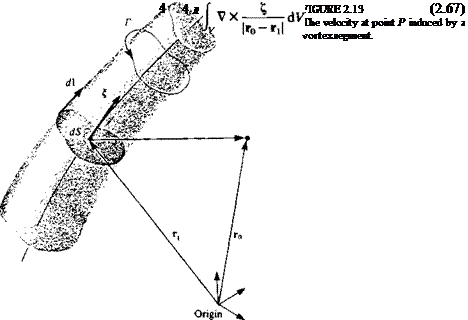THE BIOT-SAVART LAW
At this point we have an incompressible fluid for which the continuity equation is
V • q = 0 (1.23)
and where vorticity £ can exist and the problem is to determine the velocity field as a result of a known vorticity distribution. We may express the velocity field as the curl of a vector field B, such that
q = V X В (2.64)
Since the curl of a gradient vector is zero, В is indeterminate to within the gradient of a scalar function of position and time, and В can be selected such that
![]() V-B = 0
V-B = 0
The vorticity then becomes
% = V X q = V X (V X B) = V(V • B) – V2B
By applying Eq. (2.65) this reduces to Poisson’s equation for the vector potential B:
$=-V2B (2.66)
The solution of this equation, using Green’s theorem (see Karamcheti,15 p. 533) is
4л Jv |r0 —fi|
Here В is evaluated at point P (which is a distance r0 from the origin, shown in Fig. 2.12) and is a result of integrating the vorticity £ (at point r,) within the
 FIGURE 2.12
FIGURE 2.12
Velocity at point P due to a vortex distribution.
 |
volume V. The velocity field is then the curl of В
Before proceeding with this integration, let us consider an infinitesimal piece of the vorticity filament £, as shown in Fig. 2.13. The cross section area dS is selected such that it is normal to ^ and the direction d on the filament is
Also the circulation Г is
Г = £dS
and
dV = dS dl
so that
![]() V X -—-—- dV = V X Г ——-
V X -—-—- dV = V X Г ——-
and carrying out the curl operation while keeping r, and d fixed we get
rrvr dl _rdl*(rO~ri)
VXr|ro-r1|-r |r0-r,|3
Substitution of this result back into Eq. (2.67) results in the Biot-Savart law, which states
![]()
![]() Г Г dіх(г0-гі) 4л J |r0-rt|3
Г Г dіх(г0-гі) 4л J |r0-rt|3
or in differential form
_ Г dl X (r0 – rt) 4л |г0-Гі|3
A similar manipulation of Eq. (2.67) leads to the following result for the velocity due to a volume distribution of vorticity:
|
|
|
|
|
|











